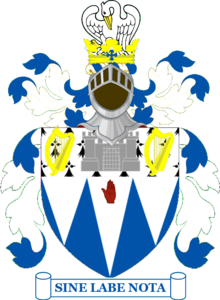Frederick Alfred Pile
Sir Frederick Pile | |
|---|---|
Early life
Pile was born in Dublin as the second child of Sir Thomas Devereux Pile, 1st Baronet and his wife, Caroline Maude Nicholson.[2] Sir Thomas served as the Lord Mayor of Dublin from 1900 to 1901.
Pile had an older sister and two younger brothers. His youngest brother, Cyril John Pile, served in the Royal Flying Corps during the First World War, and was killed in action in 1917.[3]
After attending the Royal Military Academy at Woolwich, Pile was commissioned into the Royal Artillery in July 1904.[4][5] He initially served in India, together with Britain and South Africa.[4][6]
Military career

Pile served in the First World War and was involved in the retreat from Mons and was a Staff Captain with 1st Division before becoming a Brigade Major with 40th Division in 1916.[4] In the closing stages of the War he became a General Staff Officer (GSO) with 22nd Corps in France.[4] He was married in 1915, thrice mentioned in dispatches, and awarded both the Military Cross[7] and the Distinguished Service Order[8] during the war.[9][10]
After the war he was appointed a Brigade Major at Brighton and Shoreham District.[4] He attended the Staff College, Camberley from 1922 to 1923 and transferred to the Royal Tank Corps (later the Royal Tank Regiment) in 1923.[4][9] In 1928 he became Commander of the 1st Experimental Mechanized Force and Assistant Director of Mechanisation at the War Office.[4] He went to Egypt in 1932 as Commander of the Canal Brigade Mechanized Force.[4]

In 1937 he became General Officer Commanding 1st Anti Aircraft Division. Even before the war started, he foresaw the likely pressures on personnel and investigated whether women would be capable to taking a part in anti-aircraft batteries. He invited
Tim Pile was considered as
Pile was created a
He was also Colonel Commandant of the Royal Artillery from 1945 to 1952.[4]
Personal life
In 1915 Pile married Vera Millicent Lloyd, with whom he had two sons, Frederick Devereux Pile (1915–2010) and John Devereux Pile (1918–1982). In 1932 he married Hester Mary Melba Phillimore. In 1951, he married Molly Eveline Louise Mary Home.[2]
Pile's elder son, Frederick Pile, served as a major in the Royal Tank Regiment. He won the Military Cross during the British Army's advance into Germany in 1945. He was later promoted to colonel and succeeded to the baronetcy on his father's death in 1976.[16]
Commemoration

In 1948, a locomotive of the
Arms

|
|
References
- ^ Acović, Dragomir (2012). Slava i čast: Odlikovanja među Srbima, Srbi među odlikovanjima. Belgrade: Službeni Glasnik. p. 594.
- ^ doi:10.1093/ref:odnb/31549. (Subscription or UK public library membershiprequired.)
- ^ "Cyril John Pile1". thepeerage.com. Retrieved 2 April 2016.
- ^ a b c d e f g h i j k "King's Collections : Archive Catalogues: Military Archives". Liddell Hart Centre.
- ^ "No. 27707". The London Gazette. 23 August 1904. p. 5415.
- ^ Doherty 2004, pp. 89–90.
- ^ "No. 29886". The London Gazette (Supplement). 29 December 1916. p. 39.
- ^ "No. 30450". The London Gazette (Supplement). 29 December 1917. p. 25.
- ^ a b Smart 2005, p. 251.
- ^ Doherty 2004, p. 90.
- ^ Roof over Britain, the official story of the AA Defences 1939-42. London: HMSO. 1943. p. 58.
- JSTOR 2605627.
- ^ Ordway, Frederick I III; Sharpe, Mitchell R. The Rocket Team. Apogee Books Space Series 36. p. 262.
- ISBN 1-84212-526-5.
- ^ "No. 34066". The London Gazette. 3 July 1934. p. 4222.
- ^ "Colonel Sir Freddy Pile". The Daily Telegraph. 29 November 2010. Retrieved 31 March 2016.
- ^ "side view of the locomotive showing the SIR FREDERICK PILE name and crest". Archived from the original on 26 November 2004.
- ^ "Pile Family Crest as carried by the Southern Railway (Great Britain)-Southern Railway locomotive". Archived from the original on 26 July 2011.
- ^ "34058 – Sir Frederick Pile". 34058 Restoration Group. Archived from the original on 20 June 2006. Retrieved 8 July 2006.
- ^ "Rebuilt Bulleid WC/BB 'West Country' and 'Battle of Britain' class 4-6-2". Southern E-Group. 23 June 2003.
- ^ "Rebuilt Battle of Britain Class Locomotive – Sir Frederick Pile". Hornby Railways Collector's Guide. Retrieved 31 March 2016.
- ^ Burke's Peerage. 1915. p. 1602.
Bibliography
- ISBN 978-1-85182-865-4.
- Mead, Richard (2007). Churchill's Lions: a biographical guide to the key British generals of World War II. Stroud (UK): Spellmount. ISBN 978-1-86227-431-0.
- Smart, Nick (2005). Biographical Dictionary of British Generals of the Second World War. Barnesley: Pen & Sword. ISBN 1-84415-049-6.
